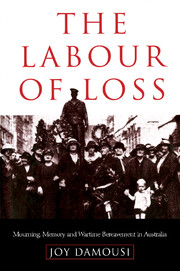Book contents
- Frontmatter
- Contents
- Abbreviations
- Acknowledgements
- Introduction
- Part I The First World War
- 1 Theatres of Grief, Theatres of Loss
- 2 The Sacrificial Mother
- 3 A Father's Loss
- 4 The War Widow and the Cost of Memory
- 5 Returned Limbless Soldiers: Identity through Loss
- Part II The Second World War
- Conclusion
- Notes
- Bibliography
- Index
1 - Theatres of Grief, Theatres of Loss
Published online by Cambridge University Press: 06 July 2010
- Frontmatter
- Contents
- Abbreviations
- Acknowledgements
- Introduction
- Part I The First World War
- 1 Theatres of Grief, Theatres of Loss
- 2 The Sacrificial Mother
- 3 A Father's Loss
- 4 The War Widow and the Cost of Memory
- 5 Returned Limbless Soldiers: Identity through Loss
- Part II The Second World War
- Conclusion
- Notes
- Bibliography
- Index
Summary
No mail now brings his cheery lines to read;
No message breaks the silence of that grave.
In writings on war, the enactment of grief is often overshadowed by the drama of battle. As in the wider conflict where loss is born, grief leaves no one unaffected by its devastation: like combat, there is no space to retreat and to take refuge from the havoc grief unleashes among those who give and those who receive the news of death.
Soldiers were messengers and chroniclers, as well as watchers and sufferers of grief. Unlike the theatre of war, where they played out their performances like actors trained in melodrama, they were given no script for this role. Their confrontation with death meant they could not act out their military selves with the control and certainty expected of them by others who witnessed battle. One soldier, E. W. D. Laing, wrote to the mother of his deceased friend, expressing his awkwardness, reluctant responsibility and individual mourning:
I was a friend of your son, Mort, & his death was a blow to me. I was away from the Bn at the time he was killed & have just got your address. Your son was one of the most loveable straight forward chaps I have ever met. This I know is the opinion of all the officers & men in the Bn … [the] world is considerably poorer through his death … I wish I could express all I feel, but believe me all my sympathy is with you … Please forgive me if I have put things crudely but [I am not] very good at expressing myself.
- Type
- Chapter
- Information
- The Labour of LossMourning, Memory and Wartime Bereavement in Australia, pp. 9 - 25Publisher: Cambridge University PressPrint publication year: 1999

